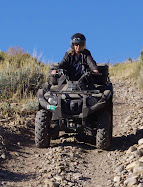 |
| Simpson Springs Recreation Area Sign |
(All information in this posting of our blog is found on signs at Simpson Springs) In 1845, it took six months to get a message from the east coast of the United States to California. By the time it arrived, the news was old. In the late 1850s, a half million people had migrated west, and they wanted up-to-date news from home. Something had to be done to deliver mail faster and to improve communication in the expanding nation.
Competing with time, distance, harsh climate and hostile Indians, the Pony Express carried important communications from the East and the West across 2,000 miles between St. Joseph, Missouri and Sacramento, California in only 10 days. The "Pony," as it was called, is an outstanding example of American Courage, endurance and determination in the westard expansion of the Nation. Speeding mail and news across the country, the Pony was then a vital lifeline of the nation. It is credited with playing an important part in preserving our nation by keeping California in the Union at the outbreak of the Civil War.
Completion of the Transcontinental Telegraph Line in October, 1861, put an end to the Pony Express. The "talking wire" met the need for urgent communications and the Overland Stage served for general letters. Despite its high prices (up to $5.00 an ounce at its peak), the Pony Express was a losing enterprise from its beginning. Receipts were often high, but expenses were enormous. In spite of its contributions to the Union ant the westward expansion, the the Pony never received any financial assistance form the government.
Yet its founders, WH Russell, Alexander Majors, and William B Waddell felt the need was important, and the Pony Express operated in the red until it went out of business on October 28, 1861, four days after the first coast to coast telegraph message. The Pony Express captured the admiration, imagination, and hearts of people.
Pony Express relay stations were from 10 to 35 miles apart along the route and each had two to four men and extra horses. About 500 of the hardiest western mustang horses were bought at prices up to $200.00 each. A healthy horse could run at a full gallop for only 10 to 12 miles, so the Pony Express needed to build many new stations in remote areas across the Great Basin. There were about 80 riders in all, and they were recruited from the most daring, determined and toughest “wiry young fellows” in the West. Lightly equipped and armed with a Navy Colt revolver, each man rode at least 35 miles in each direction, changing horses at three relay stations along the way.
Over his saddle the rider carried the mochila, a leather cover with four mail pouches of letters. He wasted no time at the relay stations, stopping only for water and to transfer the precious mochila onto a waiting horse. Day and night, good weather and bad, winter and summer, the Pony Riders covered 10 to 15 miles an hour on their routes. Surprisingly, over the 18 months the Pony operated, (April 1860 to October 1861) only one mail pouch was lost and service was held up for only one month during the Indian Wars.
Mark Twain wrote in “Roughing It,” published in 1872, about his encounter with a Pony Express Rider in the summer of 1861: “Every neck is stretched and every eye strained...Across the endless prairie a black spec appears...In a second or two it becomes a horse and rider, rising and falling – sweeping toward us – growing more and more distinct, and the flutter of hoofs comes faintly to the ear – another instant a whoop and a hurrah from our upper deck, a wave of the rider's hand, but no reply, and man and horse burst past our excited faces, and go winging away like a belated fragment of a storm.”

No comments:
Post a Comment